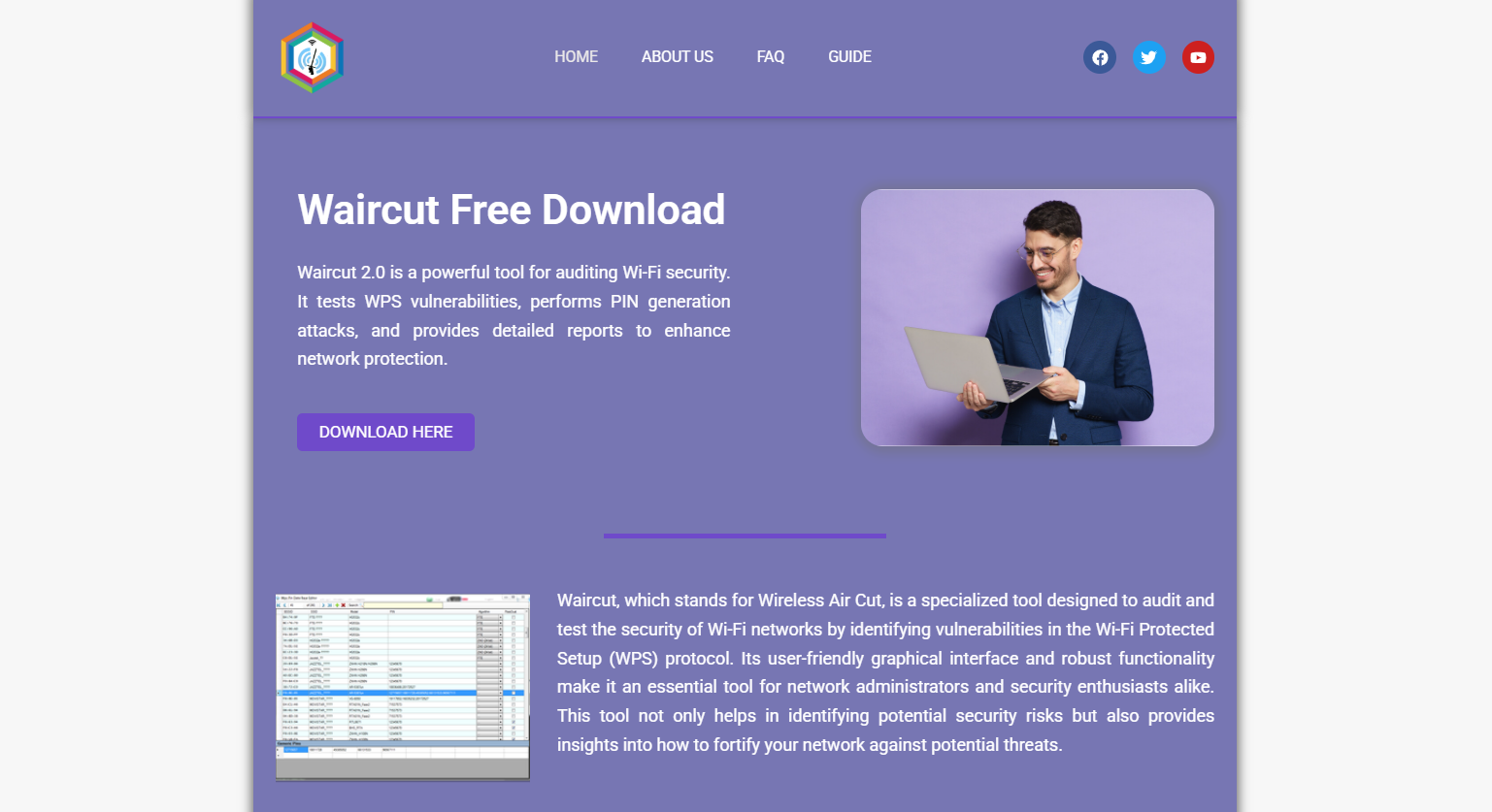Is Waircut v2.0 Safe for Wi-Fi Testing?

Waircut v2.0 has become increasingly popular among users involved in Wi-Fi security testing and penetration analysis. As cybersecurity awareness grows, especially around wireless networks, tools like Waircut emerge as attractive options for checking vulnerabilities, particularly those associated with WPS (Wi-Fi Protected Setup) protocols. This article presents an in-depth exploration of Waircut v2.0, analyzing its core functions, purpose, potential risks, legal implications, and whether it can be considered safe for ethical Wi-Fi testing.
Understanding Waircut v2.0
Waircut, which stands for Wireless Air Cut, is a Windows-based application used primarily for testing the security of Wi-Fi networks that have WPS enabled. Developed as a user-friendly GUI (Graphical User Interface) for the Reaver and PixieWPS tools, Waircut aims to simplify what is traditionally a complex command-line process. These backend tools exploit flaws in the WPS protocol, which was introduced to simplify Wi-Fi connection by eliminating the need to manually enter long passwords.
Waircut v2.0 supports a wide array of WPS PIN brute-force methods, including offline and online pin testing. It can also identify vulnerabilities by scanning for default or predictable PINs and can attempt to crack Wi-Fi keys through WPS without needing physical access to the router. These features make it extremely powerful, especially in the hands of professionals who need to audit network security.
Main Features and Functional Scope
One of the reasons Waircut v2.0 is widely discussed in cybersecurity communities is due to its extensive feature set:
- WPS Vulnerability Scanning: Detects WPS-enabled devices within range and determines whether they are susceptible to known vulnerabilities.
- PIN Brute-Forcing: Employs several algorithms and known vendor default PINs to attempt access to the Wi-Fi network.
- Pixie Dust Attack Integration: Uses an offline attack method (PixieWPS) against routers with predictable cryptographic keys.
- Updated WPS Database: Maintains a list of known default PINs from various router vendors.
- Graphical Interface: Provides ease of use compared to traditional Linux-based CLI tools.
- Compatibility with Windows: Unlike most Wi-Fi security testing tools, which are Linux-based, Waircut works natively on Windows.
These capabilities make Waircut appealing to ethical hackers and IT administrators looking to test their networks. However, its ease of access also makes it a tool that can be misused by unauthorized individuals, raising concerns about its safety and legality.
Security Risks Associated with Waircut
Despite its legitimate use cases, Waircut v2.0 is not without risk. Like any powerful software that interacts with network protocols, the potential for misuse is high. Several security-related concerns accompany its use:
- Unauthorized Access Potential: If used irresponsibly or with malicious intent, Waircut can facilitate unauthorized access to private networks.
- False Positives and System Instability: In some cases, attempting to brute-force WPS pins may cause routers to freeze or behave unexpectedly.
- Exposure to Malware: Since Waircut is not an officially signed or commercial product, users must exercise caution when downloading the tool. Downloading from untrusted sources might result in compromised versions carrying spyware or backdoors.
- Lack of Regular Updates: Waircut is not under active development by a large organization, so security patches or updates may be infrequent.
- Intrusion Detection System Flags: Enterprise-grade firewalls or IDS/IPS systems may detect and flag Waircut activities as malicious behavior, leading to administrative consequences in controlled environments.
While Waircut itself may not be inherently malicious, its misuse can lead to severe repercussions, especially when used on networks without proper authorization.
Legal Considerations
Using Waircut for Wi-Fi security testing walks a fine line between ethical hacking and illegal intrusion. The legality of using Waircut depends largely on the user’s intent and jurisdiction. In most countries, unauthorized access to a network—regardless of method—is illegal under computer crime legislation.
In ethical penetration testing environments, using Waircut is permitted only if the network owner has granted explicit written permission. Without this, even exploratory testing is considered hacking and is subject to prosecution.
In the United States, the Computer Fraud and Abuse Act (CFAA) prohibits unauthorized access to computer systems. Similarly, laws in the UK under the Computer Misuse Act have strict definitions of unauthorized use, making tools like Waircut potentially problematic unless used by certified professionals under strict legal frameworks.
Practical Use in Ethical Penetration Testing
When used correctly, Waircut can be a valuable asset in the penetration tester’s toolkit. It provides a means to evaluate the robustness of wireless security, especially WPS, which continues to be enabled on many consumer routers by default despite known vulnerabilities.
Security professionals use Waircut to simulate real-world attacks and determine if their wireless networks are vulnerable to compromise. If Waircut successfully gains access using a brute-force WPS method, that becomes a strong indicator that WPS should be disabled entirely, and stronger WPA2/WPA3 configurations should be adopted.
In such use cases, Waircut helps prevent real attackers from exploiting the same vulnerabilities. However, it must be emphasized again that testing should only be performed in environments where full permission has been granted.
Comparison with Other Wi-Fi Testing Tools
To determine Waircut’s place among Wi-Fi testing tools, it’s worth comparing it with other well-known options:
- Aircrack-ng: A more comprehensive suite for Wi-Fi testing, capable of cracking WPA/WPA2 keys through handshake capture and dictionary attacks. Unlike Waircut, it focuses more on password cracking than WPS vulnerabilities.
- Reaver: The command-line tool upon which Waircut is built. It’s more technical and requires a deeper understanding of Linux networking tools.
- Kismet: A passive Wi-Fi scanner and sniffer, focusing on detection and monitoring rather than brute-force attacks.
- Wireshark: Primarily used for packet analysis but can also be useful for understanding what’s happening on a Wi-Fi network.
Compared to these tools, Waircut provides a specialized and user-friendly solution for one particular attack vector—WPS vulnerabilities. Its simplicity and focus make it an ideal entry point for beginners in Wi-Fi testing but limit its broader utility.
Installation and System Requirements
Waircut v2.0 runs on Windows, which makes it more accessible than Linux-based penetration tools. However, its installation is not completely straightforward:
- Dependencies: Requires .NET Framework 4.0 or higher and the Microsoft Visual C++ Redistributable packages.
- Additional Tools: Needs “JumpStart” and “WinPcap” to function fully. These tools help manage wireless adapter functions and packet capture.
- Compatible Adapters: Not all wireless adapters support the necessary packet injection or monitor mode capabilities. Users may need to acquire specific network interfaces compatible with Windows packet injection.
While the tool can be installed and used on most modern Windows systems, optimal performance may require additional setup and configuration knowledge.
Community Support and Development
Waircut is an open-source project, which is both an advantage and a limitation. The tool has a small but active community of developers and users who contribute fixes and enhancements. However, because it’s not a commercial product, its future development depends entirely on volunteer effort.
Users can find support and engage in discussions through forums such as GitHub, Reddit, and specialized cybersecurity message boards. Unlike commercial tools, there is no dedicated customer support, so troubleshooting often requires patience and technical knowledge.
Best Practices for Safe Use
To use Waircut v2.0 safely, several best practices should be followed:
- Always Obtain Permission: Only use the tool on networks you own or have explicit authorization to test.
- Verify Download Sources: Download the tool from official or highly trusted repositories such as GitHub.
- Use on Isolated Environments: Perform testing on segregated or lab networks to avoid unintended disruptions.
- Keep Antivirus Active: Some antivirus software may flag Waircut due to its functionality. Ensure you understand the risks and configure exceptions cautiously.
- Update Regularly: Even if updates are infrequent, stay informed about new developments or patches.
- Avoid Public Networks: Never run Waircut on public Wi-Fi or shared networks, as this can lead to legal issues or accidental disruptions.
By following these precautions, users can minimize risks and ensure the tool is used ethically and effectively.
Implications for Network Security
The mere existence of tools like Waircut serves as a wake-up call for network administrators. Many consumer-grade routers still have WPS enabled by default, making them susceptible to attacks that can be carried out with minimal technical knowledge.
Network administrators and users should consider disabling WPS on their routers entirely. Though WPS was designed for convenience, the convenience comes at a high security cost. Advanced encryption standards like WPA3 should be implemented where possible, and strong, randomly generated passwords should be used.
Periodic security audits should also be conducted to assess all entry points to a wireless network. Waircut, when used responsibly, plays an essential role in these audits.
Conclusion
Waircut v2.0 is a powerful tool for Wi-Fi security testing, specifically targeting vulnerabilities in WPS protocols. Its graphical interface and ease of use make it a practical choice for professionals and enthusiasts alike. However, the same strengths that make Waircut accessible also pose risks if misused.
Safety in using Waircut depends not just on the software itself but also on the user’s intent, awareness, and adherence to ethical and legal guidelines. When used correctly, Waircut can enhance wireless security and protect networks from real-world threats. When used irresponsibly, it becomes a tool for intrusion and exploitation.




